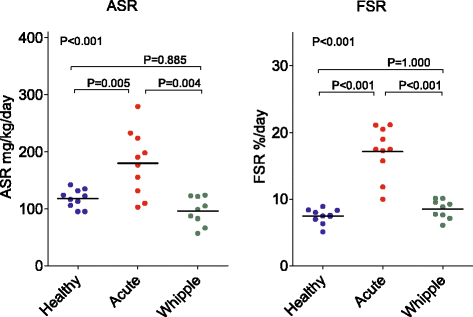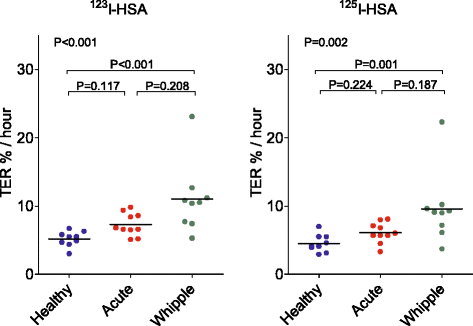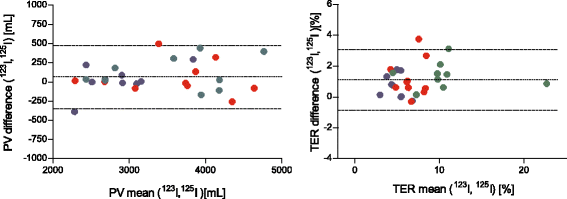Simultaneous assessment of the synthesis rate and transcapillary escape rate of albumin in inflammation and surgery
- PMID: 27846908
- PMCID: PMC5111293
- DOI: 10.1186/s13054-016-1536-6
Simultaneous assessment of the synthesis rate and transcapillary escape rate of albumin in inflammation and surgery
Abstract
Background: Better knowledge of albumin kinetics is needed to define the indications for albumin use in clinical practice. This study involved two approaches: the synthesis rate and transcapillary escape rate of albumin were measured simultaneously at different levels of plasma albumin concentration in relation to acute inflammation and surgery; and two different tracers were compared to determine plasma volume and the transcapillary escape rate.
Methods: Healthy volunteers (n = 10), patients with acute inflammatory abdominal disease (n = 10), and patients undergoing elective pancreatic resection (n = 10) were studied. The albumin synthesis rate was measured by the incorporation of deuterium-labeled phenylalanine. Plasma volume and the transcapillary escape rate were assessed using 123I-labeled and 125I-labeled albumin.
Results: A 50 % elevated de-novo albumin synthesis rate was seen in patients with acute inflammation and marked hypoalbuminemia, while patients with marginal hypoalbuminemia before the start of surgery had a normal albumin synthesis rate. The transcapillary escape rate was elevated intraoperatively during the reconstructive phase of pancreatic surgery, when plasma albumin was decreased but stable. In acute inflammation with marked hypoalbuminemia, the transcapillary escape rate was no different from normal. 123I-labeled and 125I-labeled albumin were found exchangeable for plasma volume determinations, but could be used only in groups of patients for the transcapillary escape rate.
Conclusions: This observational study illustrates the limited information contained in albumin plasma concentrations to reflect albumin kinetics. On the contrary, single measurements of the synthesis rate and/or transcapillary escape rate of albumin obviously cannot explain the plasma level of albumin or the changes seen in plasma albumin concentration.
Trial registration: www.clinicaltrials.gov , study number NCT01686776 . Registered 13 September 2012.
Keywords: Albumin kinetics; Capillary leakage; Hypoalbuminemia.
Figures





Similar articles
-
Albumin Kinetics in Patients Undergoing Major Abdominal Surgery.PLoS One. 2015 Aug 27;10(8):e0136371. doi: 10.1371/journal.pone.0136371. eCollection 2015. PLoS One. 2015. PMID: 26313170 Free PMC article. Clinical Trial.
-
Evidence for capillary leakage during chemotherapy in man.Eur J Clin Invest. 1986 Jun;16(3):243-7. doi: 10.1111/j.1365-2362.1986.tb01336.x. Eur J Clin Invest. 1986. PMID: 3089822
-
Characterization of mechanisms causing hypoalbuminemia in rats with long-term bile duct ligation.J Hepatol. 1995 Jul;23(1):79-86. doi: 10.1016/0168-8278(95)80314-9. J Hepatol. 1995. PMID: 8530813
-
Dual effect of insulin on plasma volume and transcapillary albumin transport.Diabetologia. 1992 Feb;35(2):99-103. doi: 10.1007/BF00402539. Diabetologia. 1992. PMID: 1547928 Review.
-
Hypoalbuminemia: Pathogenesis and Clinical Significance.JPEN J Parenter Enteral Nutr. 2019 Feb;43(2):181-193. doi: 10.1002/jpen.1451. Epub 2018 Oct 4. JPEN J Parenter Enteral Nutr. 2019. PMID: 30288759 Free PMC article. Review.
Cited by
-
Repeated quantitative measurements of De Novo synthesis of albumin and fibrinogen.PLoS One. 2017 Mar 28;12(3):e0174611. doi: 10.1371/journal.pone.0174611. eCollection 2017. PLoS One. 2017. PMID: 28350862 Free PMC article.
-
Kinetics of 5% and 20% albumin: A controlled crossover trial in volunteers.Acta Anaesthesiol Scand. 2022 Aug;66(7):847-858. doi: 10.1111/aas.14074. Epub 2022 May 13. Acta Anaesthesiol Scand. 2022. PMID: 35491239 Free PMC article. Clinical Trial.
-
Albumin as a drug: its biological effects beyond volume expansion.Crit Care Resusc. 2020 Sep;22(3):257-265. doi: 10.1016/S1441-2772(23)00394-0. Crit Care Resusc. 2020. PMID: 32900333 Free PMC article. Review.
-
Colloids Yes or No? - a "Gretchen Question" Answered.Front Vet Sci. 2021 Jul 2;8:624049. doi: 10.3389/fvets.2021.624049. eCollection 2021. Front Vet Sci. 2021. PMID: 34277747 Free PMC article. Review.
-
The Risk Factors for Perioperative Serum Albumin Variation in Pediatric Patients Undergoing Major Gastroenterology Surgery.Front Surg. 2021 Jan 25;7:627174. doi: 10.3389/fsurg.2020.627174. eCollection 2020. Front Surg. 2021. PMID: 33585551 Free PMC article.
References
-
- Perel P, Roberts I, Ker K. Colloids versus crystalloids for fluid resuscitation in critically ill patients. Cochrane Database Syst Rev. 2013;2:CD000567. - PubMed
-
- Annane D, Siami S, Jaber S, Martin C, Elatrous S, Declere AD, et al. Effects of fluid resuscitation with colloids vs crystalloids on mortality in critically ill patients presenting with hypovolemic shock: the CRISTAL randomized trial. JAMA. 2013;310:1809–17. doi: 10.1001/jama.2013.280502. - DOI - PubMed
Publication types
MeSH terms
Substances
Associated data
LinkOut - more resources
Full Text Sources
Other Literature Sources
Medical

